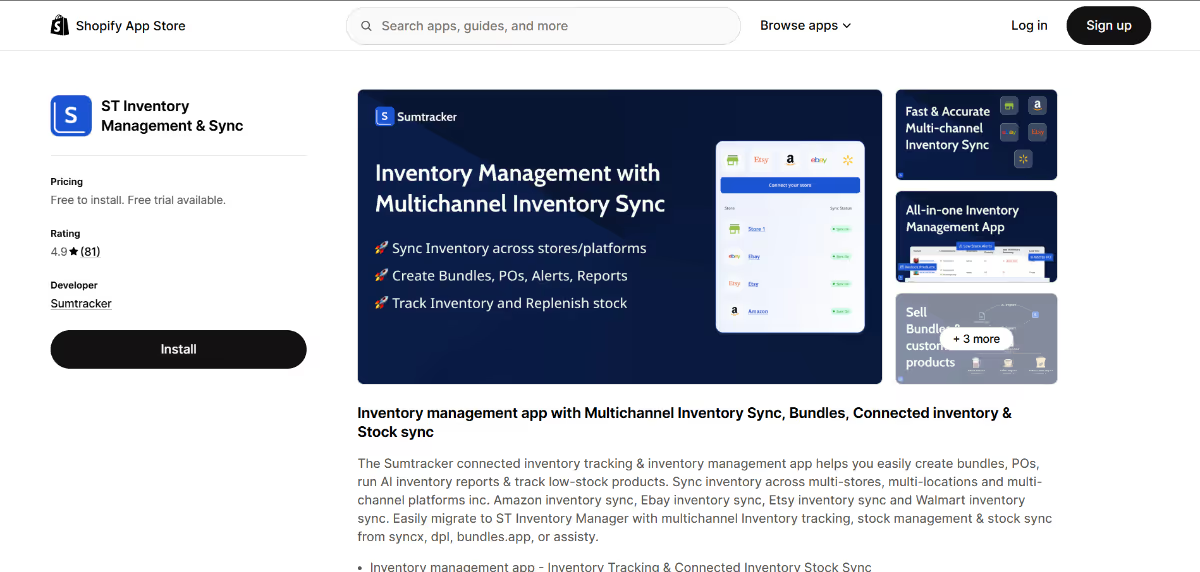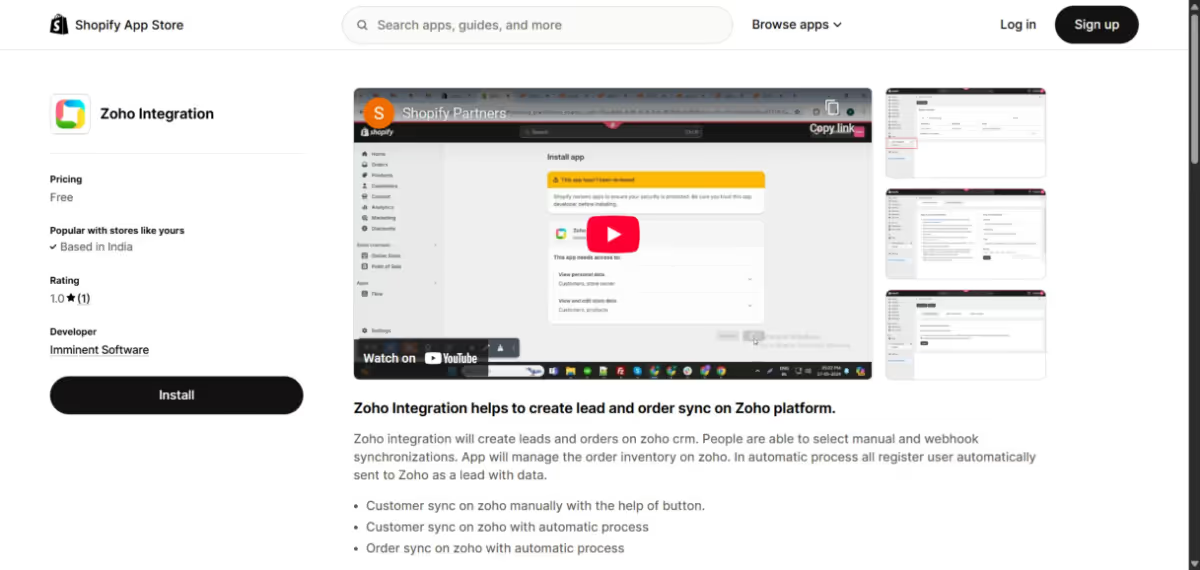Inventory chaos doesn’t care how great your products are.
One oversold SKU, one missed reorder, or one lag in syncing and your customers feel it first.
That’s why growing eCommerce brands turn to inventory software that can keep up with the speed of their sales.
Two popular choices often put head-to-head are Sumtracker and Zoho Inventory.
Both help manage stock, but their approach couldn’t be more different.
One is built for eCommerce-first brands that live on Shopify and marketplaces. The other is designed for larger operational stacks that require accounting and CRM to be integrated.
This guide breaks down exactly how they compare so you can choose the one that actually fits how you sell.
What is Sumtracker?
Sumtracker is an inventory management software built specifically for growing eCommerce brands that sell on multiple platforms like Shopify, Amazon, Etsy, eBay, and Walmart.

It gives merchants complete control over their inventory, keeping every channel perfectly aligned. Whether you're managing thousands of SKUs, handling bundles and kits, or replenishing fast-moving products, Sumtracker is designed to make these workflows effortless.
Key highlights of Sumtracker:
- Real-time multichannel stock sync (Shopify, Amazon, eBay, Etsy, and more)
- Advanced bundle and component-level tracking
- Automated purchase order workflows
- Low-stock alerts and smart restock suggestions
- Multi-location inventory and stock transfers
- Clean, intuitive UI that teams actually enjoy using
Unlike heavy ERP-style systems, Sumtracker is simple to adopt and built with eCommerce speed in mind.
What is Zoho Inventory?
Zoho Inventory is a cloud-based inventory and order management software that’s part of the larger Zoho ecosystem. It’s designed for businesses looking for a solution that provides order management, accounting integrations, and CRM capabilities.

It’s a solid platform for businesses that need inventory to work hand-in-hand with their finance and sales operations, especially if they’re already using other Zoho tools like Zoho Books or Zoho CRM.
Key highlights of Zoho Inventory:
- Inventory and order management with multiple warehouses
- Integration with Zoho ecosystem (Books, CRM, etc.)
- Serial and batch tracking, composite items
- Purchase order and vendor management
- Reports, valuation, and accounting integrations
- Tiered pricing plans with order volume limits
While powerful, Zoho Inventory can feel heavier and more complex for merchants who primarily care about eCommerce channel sync and fulfillment speed.
Sumtracker vs Zoho Inventory: Feature-by-Feature Comparison
When choosing an inventory management platform, it’s rarely about finding the “best” software in absolute terms, it’s about finding the right fit for your business model.
Sumtracker and Zoho Inventory both offer powerful capabilities, but they’re built for different kinds of merchants.
Pros and Cons
Choosing between Sumtracker and Zoho Inventory ultimately comes down to what kind of business you’re running.
If you’re a Shopify or marketplace seller who cares about speed, simplicity, and accuracy, Sumtracker gives you exactly what you need without ERP bloat.
If you’re running a more complex operation that needs accounting, CRM and inventory all under one roof, Zoho Inventory can be a better match.
Here’s how their strengths and trade-offs look side by side:
Why Shopify Merchants Should Choose Sumtracker
When you're running a Shopify store, every minute and every unit matters. Delayed inventory sync, messy bundle tracking, or poor restock planning can lead to overselling, canceled orders, and disappointed customers.
That’s exactly why Sumtracker stands out. It’s built for Shopify-first merchants, not retrofitted from a generic ERP system like Zoho Inventory.
Here’s what makes the difference:
Real-Time Sync Across Shopify and Marketplaces
Inventory moves fast on Shopify, and your system needs to keep up. Sumtracker updates stock across all connected Shopify stores and marketplaces including Amazon, Etsy, eBay, and Walmart in real time.
This means no overselling, no backorders, and no more worrying about out-of-sync stock counts.
- Instant updates when orders come in
- Works seamlessly across multiple Shopify storefronts
- Prevents overselling on bestsellers during peak traffic
Accurate Bundle & Component-Level Tracking
Many Shopify merchants sell products in bundles or kits something native Shopify and Zoho Inventory struggle with. Sumtracker was designed for this exact use case.
When a bundle sells, Sumtracker automatically deducts the right component SKUs, so your stock is always correct without manual calculations.
- Perfect for kits, packs, multipacks, and made-to-order bundles
- Component-level sync ensures real inventory visibility
- No manual bundle updates required
Smarter Replenishment & Forecasting
Guesswork leads to stockouts or overstocking. Sumtracker helps Shopify merchants plan exactly when and what to reorder, using sales velocity, lead times, and safety stock.
- Automated reorder suggestions per SKU
- Alerts before you run out of fast-moving items
- Less time spent in spreadsheets, more time scaling your store
Fast Onboarding, Zero Clutter
You don’t need an ERP system with endless menus and modules. Sumtracker is built for lean teams that want to get up and running fast.
- Intuitive UI designed for eCommerce workflows
- Easy setup most merchants go live in hours, not weeks
- Simple to train teams and delegate tasks
Purpose-Built for Shopify Growth
As your business grows, Sumtracker grows with you. Whether you’re managing a single Shopify store or multiple storefronts, it keeps inventory accurate and your operations smooth.
- Scales from startup to high-volume Shopify merchants
- Works with multiple marketplaces and warehouses
- Stays focused on what matters most fast, accurate inventory control
Case Study: How a Shopify Merchant Took Control of Inventory with Sumtracker
- Industry: Home & Lifestyle (DTC)
- Sales Channels: Shopify (Primary), Amazon, Etsy
A Shopify merchant selling bundles, kits, and multipacks across multiple channels was struggling to keep stock accurate. They initially used Zoho Inventory for its broad feature set but ran into real operational pain points as their order volume scaled.
The Challenge
- Sync delays between Shopify and marketplaces caused frequent overselling of bestsellers.
- Bundle tracking was inconsistent, resulting in negative stock on components.
- Inventory and replenishment decisions were based on manual spreadsheets, taking several hours every week.
- Adding new storefronts and SKUs required complex configurations that slowed the team down.
During their busiest sales season, they oversold hundreds of units, leading to canceled orders, refunds, and poor customer experiences.
The Switch to Sumtracker
The merchant migrated to Sumtracker with one clear goal: faster, more reliable inventory control without the complexity of an ERP system.
- Real-time sync between Shopify and marketplaces eliminated overselling issues.
- Accurate bundle & component tracking ensured component stock levels always reflected actual sales.
- Automated replenishment replaced guesswork with smart restock recommendations.
- Simple onboarding allowed the team to get up and running in days, not weeks.
Results After 3 Months
“We used to spend hours fixing inventory mistakes. Now our stock updates instantly, and replenishment happens before we hit zero. It’s a complete mindset shift.”
Why This Matters
This story isn’t unique, it’s what many Shopify merchants face when using tools that aren’t designed for fast-moving eCommerce.
Sumtracker gave this merchant:
- Real-time visibility across channels
- Confidence in bundle and component tracking
- Smart replenishment workflows
- Simpler, faster operations
The result: fewer stockouts, smoother scaling, and more time spent growing the business instead of fixing inventory.
Conclusion
Both Sumtracker and Zoho Inventory are solid inventory management solutions but they’re designed for very different kinds of businesses.
If your business runs on Shopify or marketplaces and you care about real-time accuracy, bundle tracking, and fast, clean operations, Sumtracker is the better fit. It gives you everything you need to manage inventory in one place without the weight of an ERP system.
On the other hand, Zoho Inventory works best for companies looking for a broader operational stack, especially if they’re already tied into the Zoho ecosystem for accounting and CRM.
For eCommerce-first brands, Sumtracker stands out with:
- Lightning-fast multichannel sync
- True bundle and component-level tracking
- Smart replenishment and forecasting
- Simpler onboarding and cleaner workflows
In short, Sumtracker helps merchants scale without chaos, giving them a single, reliable source of truth for their inventory.
Conclusion
Ready to Simplify Your Inventory Management?
Join hundreds of e-commerce merchants who rely on Sumtracker to save time, eliminate errors, and grow their business.
.svg)



.png)